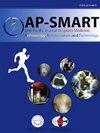目的探讨一期和二期前交叉韧带重建术后膝关节稳定性
IF 1.4
Q3 ORTHOPEDICS
Asia-Pacific Journal of Sport Medicine Arthroscopy Rehabilitation and Technology
Pub Date : 2025-09-03
DOI:10.1016/j.asmart.2025.08.008
引用次数: 0
摘要
背景:前交叉韧带重建(ACLR)手术分为一期或二期手术。但目前还没有一期和二期ACLR翻修术后膝关节稳定性比较的报道。因此,本研究旨在比较一期和二期手术后的术后前路稳定性。方法目的对35例行改良ACLR患者术后12个月用膝关节计评估膝关节前松度。结果1组19例(男9例,女10例,平均年龄26.4±11.0岁)行一期ACLR修复术;16例(男12例,女4例,平均年龄32.3±10.6岁)行2期ACLR修复术,大骨缺损髂骨移植术后6个月行分期ACLR修复术。在最后随访期(一期手术后23±9个月,二期手术后21±9个月),2例(10.5%)一期手术后手术失败,1例(6.7%)二期手术后手术失败。一期手术和二期手术后,手最大力度下前路松弛度的KT侧对侧差异分别为0.9±1.1 mm和0.9±1.3 mm,其中94%的一期手术患者和80%的二期手术患者前路松弛度值在- 1 ~ 2mm之间。我们发现一期和二期ACLR翻修术在客观前膝关节松弛度方面没有明显的技术依赖差异。结论经过至少12个月的随访,无论手术技术如何,接受一期和二期ACLR翻修的患者获得了足够的膝关节稳定性,没有其他显著差异。本文章由计算机程序翻译,如有差异,请以英文原文为准。
Objective postoperative knee stability after 1-stage and 2-stage revision anterior cruciate ligament reconstruction
Background
Revision anterior cruciate ligament reconstruction (ACLR) procedures are performed either as 1-stage or 2-stage surgeries. But there has been no report of comparison in postoperative knee stability between 1-stage and 2-stage Revision ACLR. Therefore, the present study aimed to compare postoperative anterior stability after 1-stage and 2-stage surgeries.
Methods
Objective anterior knee laxity was evaluated by knee arthrometer at 12+ months postoperatively among 35 patients who underwent revision ACLR.
Results
19 patients (Group 1: nine males and 10 females, mean age 26.4 ± 11.0 years) underwent 1-stage revision ACLR and 16 patients (12 males and four females, mean age 32.3 ± 10.6 years) underwent 2-stage revision ACLR with staged revision ACLR at six months after iliac bone grafting for large bone defects. At the final follow-up period (23 ± 9 months after 1-stage surgery and 21 ± 9 months after 2-stage surgery), procedures in two patients (10.5 %) after 1-stage surgery and one patient (6.7 %) after 2-stage surgery were found to have failed. KT side-to-side differences in anterior laxity at manual maximum force were 0.9 ± 1.1 mm and 0.9 ± 1.3 mm after 1- and 2-stage surgeries, respectively, with 94 % of patients after 1-stage surgery and 80 % of patients after 2-stage surgery showing anterior laxity values between −1 and 2 mm. We found no significant technique-dependent difference in objective anterior knee laxity between 1-stage and 2-stage revision ACLR.
Conclusions
After a minimum of 12 months of follow-up, patients who underwent 1-stage and 2-stage revision ACLR acquired sufficient knee stability regardless of surgical technique, showing no other significant differences.
求助全文
通过发布文献求助,成功后即可免费获取论文全文。
去求助
来源期刊
CiteScore
3.80
自引率
0.00%
发文量
21
审稿时长
98 days
期刊介绍:
The Asia-Pacific Journal of Sports Medicine, Arthroscopy, Rehabilitation and Technology (AP-SMART) is the official peer-reviewed, open access journal of the Asia-Pacific Knee, Arthroscopy and Sports Medicine Society (APKASS) and the Japanese Orthopaedic Society of Knee, Arthroscopy and Sports Medicine (JOSKAS). It is published quarterly, in January, April, July and October, by Elsevier. The mission of AP-SMART is to inspire clinicians, practitioners, scientists and engineers to work towards a common goal to improve quality of life in the international community. The Journal publishes original research, reviews, editorials, perspectives, and letters to the Editor. Multidisciplinary research with collaboration amongst clinicians and scientists from different disciplines will be the trend in the coming decades. AP-SMART provides a platform for the exchange of new clinical and scientific information in the most precise and expeditious way to achieve timely dissemination of information and cross-fertilization of ideas.

 求助内容:
求助内容: 应助结果提醒方式:
应助结果提醒方式:


